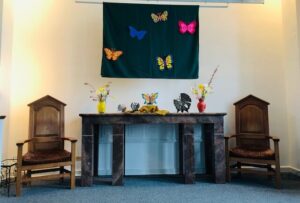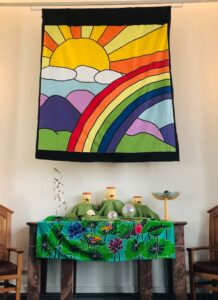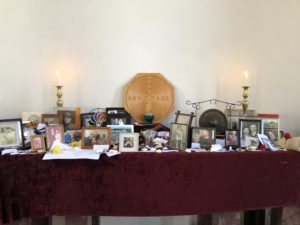In the late 80s, early 90s, Sam, Diane, and, of course, Norm, were household names. They were part of the TV “family” that gathered in a fictional Boston bar, and whose various ups and downs and absurdities formed the content of each episode. The heart of the show, though, was the idea of a place, “where everybody knows your name.” It wasn’t an instant hit, though. Out of the 77 shows in its timeslot on the night of Cheers’ premier in September of 1982, it ranked 74th. Thirty years later, however, roughly twenty years after the show ended, TV Guide put it at #11 on their list of the “60 Greatest Shows of All Time.” For many, during the decade it was on, Cheers was the epitome of “Must See Thursday.”
Sometimes you want to go
Where everybody knows your name,
And they’re always glad you came;
You want to be where you can see,
Our troubles are all the same;
You want to be where everybody knows your name.
[Feeling a little nostalgic? Of course, the fact that I think of this as bringing a contemporary reference into these reflections shows just how old I really am.]
“Call it a clan, call it a network, call it a tribe, call it a family. Whatever you call it, whoever you are, you need one.” I come back to this quote from the English novelist Jane Howard over and over again. “Call it a clan, call it a network, call it a tribe, call it a family. Whatever you call it, whoever you are, you need one.”
Since its inception in 1972, the General Social Survey has gathered data on contemporary American society in order to monitor and explain trends and constants in attitudes, behaviors, and attributes. Hundreds of trends have been tracked in those years. Actually, since the GSS adopted questions from earlier surveys, trends can be followed for nearly 7 decades.
1985 was the first year that the GSS collected data on the number of confidants with whom Americans discuss important matters. In the 2004 GSS the authors replicated those questions to assess social change in core network structures. Discussion networks, as they’re called, were significantly smaller in 2004 than in 1985. The number of people who said that there is no one with whom they discuss important matters nearly tripled. In her article, “The Loneliness of American Society,” Janice Shaw Crouse interpreted the data like this:
“a quarter of the respondents — one in four — said that they have no one with whom they can talk about their personal troubles or triumphs. If family members are not counted, the number doubles to more than half of Americans who have no one outside their immediate family with whom they can share confidences. Sadly, the researchers noted increases in “social isolation” and “a very significant decrease in social connection to close friends and family.”
This has become almost a mantra: we are the most connected society in the history of humanity, and also the loneliest.
Dr. Emma M. Seppälä is Associate Director of the Center for Compassion and Altruism Research and Education at Stanford University and Co-Director of the Yale College Emotional Intelligence Project at Yale University. She wrote an article forPsychology Today titled, “Connect To Thrive: Social Connection Improves Health, Well-Being & Longevity.” In it she wrote:
Social connection improves physical health and psychological well-being. One telling study showed that lack of social connection is a greater detriment to health than obesity, smoking and high blood pressure. On the flip side, strong social connection leads to a 50% increased chance of longevity. Social connection strengthens our immune system […], helps us recover from disease faster, and may even lengthen our life. [She notes research by Steve Cole, Professor of Medicine and Psychiatry and Biobehavioral Sciences in the UCLA School of Medicine, which shows that there are actually genes impacted by social connection, and that these also code for immune function and inflammation.]
It’s easy to scape goat technology – the rise of social media, in particular – to explain the seeming conundrum of our being connected yet alone. “All that time spent on Facebook, Twitter, Snapchat,” many people say, “and maybe particularly all the MMORPGs, those Massively Multiplayer Online Role-Playing Game, that “all the kids” seem so obsessed with, look like they’re providing community, yet it’s a very shallow kind of community.” (I said, “all the kids” are obsessed with these games, yet there are quite a few adults who are massively pumped and have already bought their Season Five Battle Pass in hopes of finding out just what the heck is up with those cracks in the sky in Fortnite. Or so I’ve heard. But I digress.) It’s common to hear people opine that social media offers only pseudo-connectivity, a mere simulacrum of the real thing.
Not so fast, other experts say. A study carried out at the University of Exeter in the United Kingdom, reported in Science Daily, observed, “Training older people in the use of social media improves cognitive capacity, increases a sense of self-competence and could have a beneficial overall impact on mental health and well-being.” And a 2010 study led by Abilene Christian University found that, “students who returned to school after freshman year had significantly more Facebook friends and wall posts than those who didn’t return.” Reporting on it for Wired, Brian Chen wrote, “Rather than being an escape from reality, social media may mirror real life: More actively connected students on Facebook were most likely also connectors in the real world. He quotes the lead on the research saying, “The study was able to show that these students who are more active on Facebook are also out there getting involved, making new friends and taking part of activities that the university provides for them.”
So what is this all about, this apparent fact that we, as a society, are increasingly disconnected even in our overly-connected world? I’m going to go out on a limb here, and suggest that at least part of the reason is that relationships – real, deep, meaningful relationships – are a lot of work. And I think they’re hard in at least three ways.
First, relationships take time. Real, deep, genuine, heart-to-heart relationships don’t appear suddenly, out of nowhere, fully formed from the head of Zeus (as it were); they don’t get heated up in a microwave, they need to simmer, to slow cook. Part of it is longevity – our deepest relationships are often with people who’ve known for a long, long time. They’re with people with whom we don’t have to recount the details of our lives again and again, because these friends have been there through the good times and the bad. This means they also take time invested. Being there through the good times and the bad times requires us to actually be there through the good times and the bad times, and that takes time.
Oh, I know that a lot of folks have friends with whom we’re in touch only sporadically yet with whom, when we are in touch, it seems that we pick up right where we left off as if no time had passed at all. Of course, usually such relationships were already deep, yet often these aren’t people who’d meet the criteria the GSS uses in their studies. I once heard the kind friendship the GSS is talking about as people I know I could call in the middle of the night and who would drop everything and get in their cars or on a plane to go from wherever they are to wherever I am in order to be with me. That significantly lowers the number of people on my list.
A second reason real, deep, genuine, heart-to-heart relationships are hard is because they require commitment. They require us to hang in there even when the relationship gets strained. We have to be there for each other “through thick and thin” not only in relation to the world around us, but the world between us as well. The “good times and the bad times” doesn’t just refer to the promise that you will be there for me when I experience good times and bad times, and that I’ll do the same for you. It means that we’re there for and with each other when we, together, when our relationship is going through good times or bad ones. To take something I often say to my kids, it means continuing to love each other even when we don’t particularly like each other very much.
And that’s hard, isn’t it? That’s really hard. When you think that I’ve offended you; when I think that you’re being unfair and nasty to me. When I’ve hurt you, and you’ve hurt me. I’m not talking about obviously unhealthy, abusive relationships. Let’s be clear about that. I’m not talking about “sticking it out” through any kind of abuse “for the sake of the relationship.” There’s a power imbalance there, and can be real danger, and that’s not what I’m talking about. (I would argue, that’s not really – can’treally be – the kind of deep and genuine relationship we’re talking about here in the first place.) I’m talking about otherwise healthy, equal, mutual relationships which have stood the test of time yet which are, right now, strained to the point perhaps even of breaking. I’m talking about taking a deep breath and leaning into that discomfort, knowing that the relationship is, ultimately, worth it.
Because that experience of someone knowing our name, really knowing who we are, and always being glad we came, no matter what’s going on with me or between us – that’s a deep human longing. More than that, it’s a deep human need.
And it’s one of the reasons for faith communities. It’s one of the reasons that people come together in places like this – we’re looking for a place in which we feel known, seen for who we are, appreciated, and loved. We’re looking for a place, and a people, in which, and by which, we feel that we belong. And think about it – if a real, deep, genuine, heart-to-heart relationship is really hard work between two people, then it’s got to be a whole lot harder among hundreds. The complexity, the challenges, the opportunities for disappointments and pain, the work of it, is all exponentially increased.
Those of you who have been waiting for me to name the third reason I think relationships in which we’re really known are such hard work, here it is. Truth be told, they’re scary. For many of us it is so, so, very, very scary. Because being known, deeply and fully, requires us to open ourselves up deeply and fully. It requires me to really trust showing you who I really am, allowing you to see who I really am down beneath what I show to the world; it requires my showing you the truths of who I am that I don’t want anyone to see.
A few years ago, when we did the Beloved Conversations program here, quite a number of us took part in the weekend workshop with which it begins. The last exercise of the first evening had a profound impact on a lot of us, I’d dare say on most of us. I won’t go through the whole thing this morning, but suffice it to say that it brought us in deep enough to look at, and name, our deepest, most fundamental fear. We did this on our own, but then we were asked, if we were willing, to share them with one another. And here, in this sanctuary, with the protective shroud of nighttime’s darkness around us, person after person dared to speak aloud their deepest fear. These were folks many of us would identify as leaders in the congregation, people we’d identify as those we admire, and some we might say we aspire to be more like. And nearly every one of these strong, wise, successful people said nearly exactly the same thing: “I’m afraid that if people really knew me, they wouldn’t like me.” I’m afraid that if people really knew me, really knew “my name,” really knew me deeply, genuinely, and in a truly heart-to-heart way, they wouldn’t like me. I wouldn’t be accepted. I wouldn’t be loved.
And that’s the Catch-22, isn’t it? In our desire to belong, to be deeply known, we hide sometimes great swaths of ourselves for fear of being rejected, being told that we don’t belong. The third thing that makes these real relationship we seek so very, very hard is that we want to be known, and yet we don’t want to risk actually being known. We don’t think we can risk it.
So here’s the thing – to the extent that we do risk it, to the extent that we do allow both the good times and the terrible, horrible, no good, very bad times to have equal freedom between and among us, to that extent and only to that extent will our relationships be the kind of real, deep, genuine, heart-to-heart relationships we want and which, ultimately, we need (not just for the sake of our immune and inflammation related genes, but for our souls).
This can be such a community, my friends. This has been such a community for many of us over the years, and hard as it can be to believe at times, I truly believe that this is such a community right now. Challenges, difficulties, disagreements – even hard and harsh ones – are not necessarily a sign that things are going wrong. It’s what we do with them that determines what they mean for us. If we lean into them; if we commit ourselves to sticking with it and each other; if we do lean into the discomfort (while clearly rejecting any abusiveness we might see); if we remember that the relationships that are this community are, ultimately, more important than the transitory happiness and satisfaction of any one of us; if, in other words, we do the hard, hard work real relationships require, we can, we will, prove to one another and to ourselves that even when we do show each other who we really are, we will be accepted and loved for who we are. This then will be for us – each of us and all of us; you, me, and those who’ve not yet even found this community – this will then truly be a place where everybody knows our name, and really, truly are glad we came. It is my hope that each of us can find even a taste of that here, and that each of us will do what we can to ensure that this is such a place for others.
Pax tecum,
RevWik












